Page 1 Page 2
I wish I could say something smart-sounding about what sustained my interest in Psychonauts. Like “I was blown away by the originality of Schafer’s conceptualization, and the way it was executed.” Or: “The story was beautifully linked to the art of the game via clever visual metaphors, such as floating specters that represented figments of the host’s imagination, sobbing pieces of luggage that signified emotional baggage waiting to be sorted, and bouncing vaults that stored reels of shameful or traumatic memories.” But if I’m going to be honest with myself, I must confess that I was in no way lucid enough in my understanding of game design to articulate my thoughts in technical terms. Of course, I’m sure on some level, my enjoyment of the game was driven by a subconscious appreciation for the well conceived story arcs, appealing character designs that complemented characters’ personalities, and the thoughtful way in which the level designers built each dreamscape to convey characters’ unique (often lunatic) perceptions of the world and their place in it. But if I traveled back in time to, say, give myself a questionnaire on why playing Psychonauts pulled me into gaming, I would have thought about it in terms of positive associations and at best, literary devices. My responses would have been as follows:
How do the game’s aesthetics appeal to you?
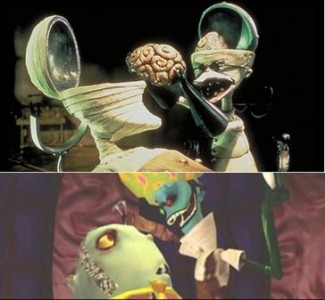 I love how bright and rich the colors are and how the environment is stylized in such a wacky, cartoonish way. Also, I love how dark it can be. Dr. Loboto reminds me so much of Dr. Finklestein from The Nightmare Before Christmas. And during the second half of the game, when darkness descends upon Whispering Rock Psychic Summer Camp, the ominous clouds in the sky resemble tortured faces. Lastly, there are brains everywhere.
I love how bright and rich the colors are and how the environment is stylized in such a wacky, cartoonish way. Also, I love how dark it can be. Dr. Loboto reminds me so much of Dr. Finklestein from The Nightmare Before Christmas. And during the second half of the game, when darkness descends upon Whispering Rock Psychic Summer Camp, the ominous clouds in the sky resemble tortured faces. Lastly, there are brains everywhere.
What do you enjoy about the writing in this game?
I love the quirky Day of the Tentacle-esque sense of humor that ripples throughout every conversation, cut scene, and internal monologue. The writing is a tinge darker, though, than you’d find in DoTT or Sam and Max. For example, Dogan has to wear a foil hat to avoid accidentally killing people with his psychic abilities (which he actually did once). Also, he is tormented by the camp squirrels and clumsily denies exploding them when Raz asks how they disappeared. An even more obvious example would be the fact that there is a nearly abandoned insane asylum in the middle of the camp’s lake.
It’s amazing how the writers were able to tackle a dark subject like clinical insanity in humorous and downright adorable ways. In my four years as an English and Classical Studies major in college, I never encountered any material that did such a fine job of balancing levity with such hauntingly dark subject matters. Psychonauts somehow managed to make poking around schizophrenic and manic depressive minds…fun! In discussing this aspect of the game, I can’t help but think of the level – Gloria’s Theater, in which Raz enters the mental world of an aging former child actress who suffers from Bipolar Disorder. When I first came upon her at Thorney Towers [Home for the Disturbed], she seemed totally innocuous and even friendly. A little deranged, perhaps, but not the least bit threatening in her demeanor. It wasn’t until I picked up her trophy that the darker side of her mania appeared, as she transitioned from oblivious crazy-talk to psychotically accusing me of believing she’s unworthy of the trophy and of asking too much from her. As I watched Gloria unravel and suddenly bear down on me menacingly, for an instant, I was actually dumbfounded with horror; she reminded me so much of Bette Davis’ chilling character in the 1962 thriller, What Ever Happened to Baby Jane? In that film, Davis plays a former Vaudevillian child star who, since her fall from fame, has devolved into becoming a high-functioning psychotic. I’m really curious as to whether Schafer was thinking of Baby Jane when he created Gloria. Anyway, before I knew it, I was running around gleefully in the theatrical playground that is Gloria’s inner world, courageously confronting her phantoms, including a porcine theater critic, and championing the beautiful damsel in distress, Bonita Soleil, who represents Gloria’s inner light. [Incidentally, fans of Lumpy Space Princess and Dr. Girlfriend would surely get a kick out of Bonita Soleil, if you catch my drift.] Interestingly, similar to how Gloria flips erratically between cheerful banter and angry outbursts, the setting in her mind manically oscillates between a sunny children’s stage play and nightmarish chaos.
Why do you care about the central characters?
Who wouldn’t empathize with an adorable young outcast in his quest to find acceptance among like-minded individuals as well as his heroes? Moreover, anyone who’s ever had a major disagreement with his/her parents can relate to the dissonance in Raz’s relationship with his father. Can the kid prove to his dad, in time, that following his dreams is the right and optimal path for his life? It’s a great coming of age setup and the interactive aspect of the gaming medium makes this particular story inherently more engaging than any Bildungsroman I’ve read. Furthermore, I love that not only does Raz prove himself to his father, but it is revealed that the two share more common ground than we thought. The reconciliation between father and son at the end of the game actually feels believable and heartwarming, instead of cheesy and contrived like the end of a “Full House” episode.
It’s also worth mentioning that in addition to Raz being a wonderfully sympathetic character, the writers also did a fantastic job of creating meaningful back stories and arcs for the secondary characters. The most extraordinary example of this was the revelation that Secret Agent Milla Vodello’s fabulous, effervescent persona is actually a defense mechanism she developed to suppress the trauma and guilt of having lost an entire orphanage of children to a deadly fire. [Yeah! That is some HEAVY shit!] And the way we learn Milla’s secret is purely accidental, as the writers chose not to make this discovery an actual plot point. There aren’t even any collectibles in that part of Milla’s mind! If you’re not careful to explore every crevice of her world, it’s extremely easy to get distracted by the disco-party shenanigans going on all around you, and more likely than not, you’ll miss the secret room at the waaaaaay tippy top of one of the chambers. In that small, eerie room, which resembles a nursery, there sits a large toy chest and if you have Raz open it and jump in, he drops into a literal hell hole where he’s encircled by demons that loudly whisper in disembodied children’s voices: “Help us, Milla! Why did you let us die?” (I shudder at the thought that I could have gone through the entire game without learning the most essential part of Milla’s back story!) After experiencing this disturbing and wholly unexpected scenelet, as I rejoined the (now extremely comforting) disco party/levitation course, I realized that my previous affinity towards Agent Vodello had suddenly deepened to genuine feelings of affection and tenderness. The contrast between her sweet, confident demeanor and her deeply buried vulnerability evoked such a strong sense of pathos; subsequently, I truly wanted her to find peace and solace in her blossoming relationship with Agent Nein.
Okay, I think you get the idea. I just realized I could probably write a whole book on my love for Psychonauts. Well, maybe that’s hyperbolic. But definitely a thick pamphlet. I could fill a thick pamphlet with my thoughts on the genius of this game. So I’ll just spare anyone reading this and conclude here by saying that what I felt upon re-entering the world of gaming by way of Psychonauts was akin to what Alice must have felt on the other side of the looking glass. Except the universe Double Fine crafted is even more clever and astonishing–I still can’t get enough of poking around every corner in Boyd’s, Edgar’s, Gloria’s, and Linda the Lungfish’s psyche-scapes. And similar to the melancholy we all feel upon reading the final sentence in a truly good book–upon seeing the credits roll at the end of my first play-through, I felt like I had just reluctantly bid farewell to some extraordinarily close friends.
Another thing that struck me, in terms of comparing my experience playing Psychonauts with the journeys I’ve taken alongside my favorite literary characters, is the writers at Double Fine made it a point to reward those players who really took the time to explore and reflect on all facets of the game. Take the Milla Vodello level, for instance. A lot of players have expressed frustration with the levitation course, because it not only contains an excessive number of collectibles in the form of figments, but the level’s logistics also make it excruciatingly difficult to acquire even half of them. Moreover, people tend not to take this level seriously, because the whole thing is dressed with festive disco motifs and it seems like the sole purpose of Milla’s mental world is to provide a tutorial on Psi Floating. But for the truly discerning explorer who makes the discovery that all the superficial fabulousness is Milla’s way of coping with her deeply buried anguish, all the things that previously seemed silly suddenly carry truly interesting implications for the player to consider. For instance, perhaps the insane number of figments of imagination demonstrates just how hard Milla works to maintain the fiction that everything in her head is just as fabulous as her swanky outer appearance suggests.
And this is just one of numerous examples embedded in the game that illustrate how satisfying a well-crafted story can be. I suspect it was the confluence of this kind of intelligent writing with the extraordinary art and level design that made Psychonauts my gateway drug for gaming. I firmly believe that anyone–no matter how virginal or experienced s/he may be as a gamer–would be moved by the level of artistry and imagination that went into this game’s creation. And I will always be grateful to Double Fine for rekindling a spark that hadn’t lived within me for what seemed like an incredibly long, sleepy lifetime.
Page 1 Page 2

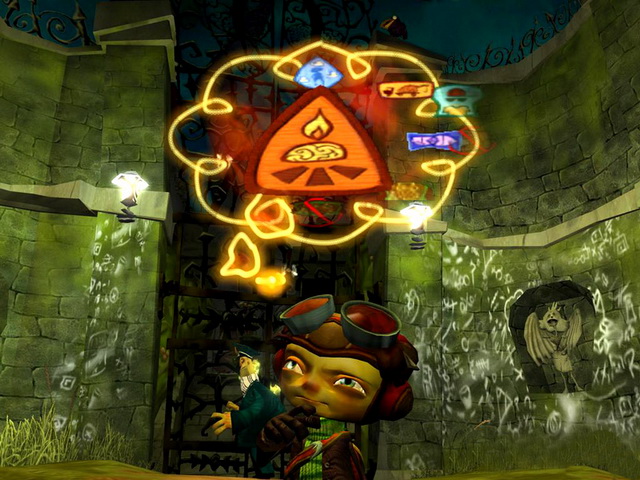
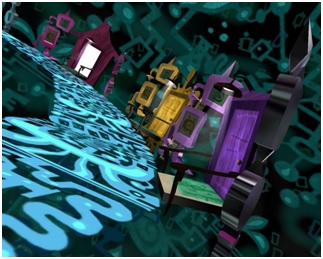
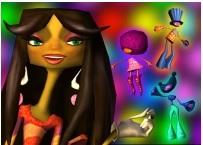
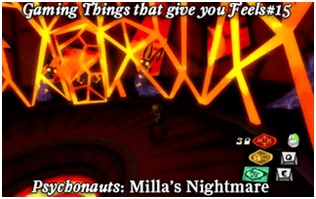
4 Comments